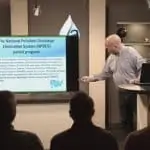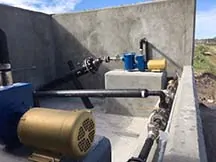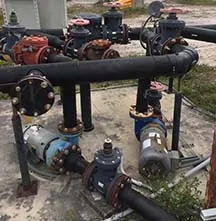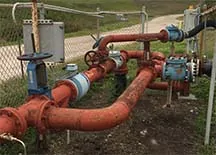

As a national environmental consulting and contracting firm specializing in managing hazardous substances, SCS Engineers is helping our clients now. Start by reading The Environmental Dangers of PFAS and Technologies for Removing Them, published in WasteAdvantage magazine for use in the solid waste industry and other industrial applications in support of EPA’s Action Plan.
On February 14, 2019, the U.S. Environmental Protection Agency (EPA) Acting Administrator Andrew Wheeler announced EPA’s Per- and Polyfluoroalkyl Substances (PFAS) Action Plan. The PFAS Action Plan is in response to public interest and input the EPA has received over the past year. EPA’s Action Plan identifies both short-term solutions for addressing these chemicals and long-term strategies for states, tribes, and local communities need to provide clean and safe drinking water to their residents and to address PFAS at the source. These actions include:
Contact a local SCS professional at or visit our website.
… we will certainly work toward making a smoother, more resilient project experience for you. Here’s one reason why:
To anyone experienced with siting new utility infrastructure that environmental planning and permitting is often a complex undertaking. Shane Latimer’s article provides guidance to help smooth the process and keep your project on time and on budget.
Project permitting, especially for linear infrastructure, generally requires planning at federal, state, and local levels, often spanning multiple jurisdictions. Integrating all of the planning and permitting processes of each level, and each community, into a cohesive plan, is crucial in managing budgets and timelines and, most important, stakeholder expectations. Changing regulations or government agencies may further complicate the process, because they do not have specific permitting timeframes or their decisions are subject to legal challenges.
In his article, Shane discusses the current general environmental regulatory context, followed by an integrated approach to permitting we use, which consists of three main pillars:
Along the way, he shares the typical pitfalls that often befall project managers that may not be well-versed in environmental permitting. Lastly, Shane lists the top permitting issues that seem to be challenging practitioners most. These elements in your earliest project development may not allow you to foresee every problem, but it will certainly make for a smoother, more resilient project experience.
Here’s another reason, we are driven by client success!
I’d like to read Integrated Environmental Planning and Permitting Enables Project Success

About the Author: Dr. Shane Latimer, CSE, is an ecologist and an environmental planner with over 20 years’ experience in environmental assessment, planning and permitting. He specializes in SCS Engineer’s client projects that are often large, complex, or controversial, and involve a combination of land use, environmental permitting, and other constraints.
Stormwater Regulation is evolving, pushing more responsibility on to the dischargers by holding them accountable through categorization based on a discharger’s ability to meet numeric benchmarks. Additionally, how a discharger responds and applies effective BMPs determines their status. Ultimately, it is up to the industrial permittee to take the initiative, with an eye to priorities and feasibility for the future of their stormwater compliance program.
Stormwater managers and facility compliance personnel have only just begun to come to terms with the tiered ERA Response paradigm. However, as the tiered escalation becomes more common and ERA Level 1 and Level 2 reporting is performed, facilities are beginning to reach an equilibrium of stormwater compliance in terms of strategy, feasibility, budget and allocation of resources.

In his whitepaper, Jonathan Meronek, QISP, ToR, takes readers through the fundamental components of the ERA, Exceedance Response Action, or tiered Corrective Action compliance mechanism already in place, and currently being implemented in the States of California, Washington and the most recent General Permit in Oregon. ERA has wide-reaching implications for future NPDES permittees of industrial stormwater discharges. The escalation or “tiered” response standards is based on EPA Benchmark Levels and potential for future Numeric Effluent Limits (NELs). The three western states are viewed as “precursors” of what may be expected throughout the United States, as several key components of the forthcoming Multi-Sector General Permit (MSGP) will push other states to move towards similar ERA response scenarios and regulations.
Regulatory and siting restrictions are such that many solid waste operators prefer to expand their existing landfill footprint as much as possible instead of finding a new disposal footprint at a different location. As landfills are getting larger in height and greater in footprint area, the location of leachate tanks, leachate ponds, or discharge points to an on-site or off-site leachate treatment plant usually does not change. A larger footprint means leachate force mains are getting longer forcing the existing pumps to work harder to push leachate through the system to a target point. Some operators carry on with the same pumps for decades and do not monitor the performance of the pumps after expanding the landfill footprint, which could be more costly in the long-term.

Hydraulic Evaluations for Lateral Expansion
The longer leachate force main with possibly additional bends in the line increases friction in the line and causes flow rates to reduce to unexpected levels. We recommended that landfill operators evaluate the performance of the existing pumps along with new pumps when designing a lateral expansion. Such an evaluation may require hydraulic analysis of the entire network of pipes along with pumps, or only the segment of the network affected by the expansion. However, the effort is minimal in comparison to the operating costs of inefficient flow and overtaxing the equipment.
Sometimes the results of a hydraulic evaluation may require up-sizing all or specific pumps in leachate sumps because not enough flow can go through the force main due to high friction loss in the expanded leachate force main. Up-sizing pumps may be achievable depending on the type of the leachate sump, i.e., riser system or vertical manholes. If the up-sized pump in a riser system is too long to fit inside a riser system, or so long that it makes routine maintenance too cumbersome, your engineer may consider enhancing the functionality of the design.

Inline and Offline Pumps
Booster pumps located along an expanded leachate force main can certainly be an option. Booster pumps can be the inline or offline type. Install the inline pumps on the actual force main, and position the offline type on the side so that liquids go through bends and elbows to reach the pump, and again through bends and elbows to get back in the force main. In either case, the booster pump adds hydraulic energy to the flow inside the force main to push the liquids at a compensated pressure through the remainder of the force main and to the target point.
Operators need to be aware of the dynamic nature of the leachate piping network and the role of booster pumps in the dynamic environment. Changes to the flow in the force main may change following a landfill expansion when the new cells are coming online increasing leachate generation. Alternatively, after closing portions of the landfill slopes, that decreases leachate generation over time. Sometimes booster pumps have to be up-sized or downsized depending on the flow and pressure in the system.

Optimizing Performance, Reduce O&M Costs
The cost of replacing pumps, up-sizing, or downsizing, is insignificant compared to the revenue that landfills generate. Proper adjustment of the pumping system keeps the entire network operating at the appropriate range of pressure, and velocity in the line; increasing the life of the pumping system. Less wear and tear on the system produces a reduction in maintenance costs along with less equipment downtime.
Lower maintenance requirements may also reduce the number of personnel required to keep the system in operational condition. Landfills with a large pumping system employing a second technician because of the high maintenance of multiple pumps may find a single technician sufficient for the upkeep of the system. Proper sizing of pumps and operating the pumping system as designed within the evaluation parameters can significantly reduce the cost and frequency of pump maintenance.

Landfill Engineering and Leachate Management
SCS Engineers promotes Carlo Lebron to lead the Southeastern region operations, including all environmental consulting, landfill, landfill gas, and solid waste business. He commences his responsibilities immediately, under the title Business Unit Director, and is managing the staff and business operations of six offices in Florida and Georgia, and including projects in Puerto Rico. His primary office is located in Tampa, Florida.
Reflection, as a means of self-evaluation of the robustness of your refrigeration management system, is critical to the continuing success of your program.
Proper planning is another vital element of your program. Together, they will help ensure the continuing safety of you, your employees, and the public.
Bill Lape, a Certified Industrial Refrigeration Operator and a member of the National
Board of Directors of RETA is a Project Director for SCS Engineers. In his most recent article, Bill provides advice to use January and early February as a time of reflection and a planning period. We need to look closely at our ammonia refrigeration management programs, be they Process Safety Management (PSM) / Risk Management Plan (RMP) or Ammonia Refrigeration Management (ARM) for facilities with less than 10,000 pounds of
ammonia in their process.
Click to read the article, and thank you for interest in maintaining safety standards.
Process Safety Management, Risk Managment Plans, Ammonia Refrigeration Management information.
At EUEC 2019 learn how SCS can minimize leachate and contact water management at coal combustion residual (CCR) landfills using good design, physical controls, and operational practices.
Through this SCS presentation of case studies, you will learn how to assess leachate and contact water management issues and implement techniques to minimize leachate and contact water management at your landfill.
Leachate management and contact water management at CCR landfills can be expensive, cause operational headaches, and divert valuable resources from other critical plant needs. Our presentation will provide you with useful tools to ensure your landfill is designed and operated to effectively reduce leachate and contact water and alleviate operator stress. We will present case studies that highlight how design features, physical controls, and operational practices have effectively decreased leachate and contact water management at CCR landfills.
2019 EUEC in San Diego, February 25-17, 2019. Conference details here.
Even the simplest impoundment closures come with design challenges. It is a challenge to navigate project constraints, whether technical, regulatory, or financial, to design and implement an effective closure strategy. Cost often helps to determine the “balance” between project constraints when the future end use of a closed CCR surface impoundment or the property it occupies is undefined. When a post-closure end use is defined, finding balance among project constraints to best serve that future use provides rewarding challenges.
SCS Engineers has navigated this balancing act on impoundment closure projects during generating facility decommissioning. Through a presentation of case studies, you can learn how this team has approached ash pond closure planning and execution where the future use of the impoundment site ranged from undefined to the home of a new solar photovoltaic installation. Examples also include potential future industrial use or property sale.
Case studies will highlight how geotechnical, hydrological, regulatory, or simple physical constraints have influenced the design and implementation of CCR surface impoundment closures.
EUEC 2019 in San Diego, February 25-27, 2019. Conference details here.
Today’s landfill design professionals can help eliminate unsafe configurations and institute features that can proactively warn of and minimize hazards for operator and customer safety. Designers consider subgrade conditions, geotechnical factors and regulatory requirements when specifying how steep a landfill may be constructed.
The practical aspects of landfill operations and maintenance play a significant role in slope configurations since the landfill must provide safe access to monitoring points, environmental control features, and mowing.
Bob Gardner highlights the most important features to consider for landfill cells, including the design and construction phases of the entire landfill’s infrastructure. Bob covers a broad range of topics including:
Many states regulate the maximum design slope, and although these vary, it is up to the landfill designer to take practical, safety and regulatory considerations into account when establishing the slope configuration. Bob recommends working closely with the field staff to incorporate a design that is user-friendly, effective and safe.
Read the WasteToday article “Ensuring safety during landfill design,” by clicking here.
About the Author: Bob Gardner, PE, BCEE
One of the most important regulatory requirements on landfill bottom lining system drainage layer is that the maximum head of leachate over the liner should not exceed 1 ft. When this requirement was developed, the consensus was that the drainage layer consisted of granular materials. Later, when geonets and geocomposites entered the market, the unwritten consensus among solid waste engineers and regulators was that the maximum head of leachate at the base should not exceed the thickness of the geonet or geocomposite drainage layer.
With that in mind, the reduction in hydraulic transmissivity of geocomposite laid over steeper slopes can adversely affect the maximum leachate head over the liner. When hydraulic transmissivity value reduces due to steeper slope at the base, the hydraulic conductivity reduces in turn as well. Reducing hydraulic conductivity results in an increase in the maximum head of leachate passing through the geocomposite.
Read Dr. Ali Khatami’s design advice for cell base slopes under these circumstances to maximize hydraulic transmissivity; recently published in the winter edition of Talking Trash.
Additional Resources: